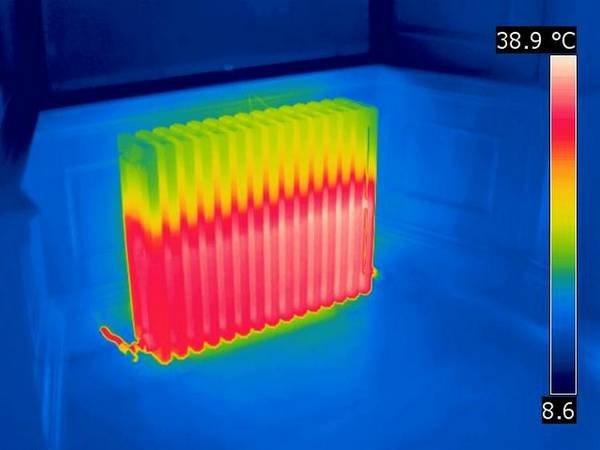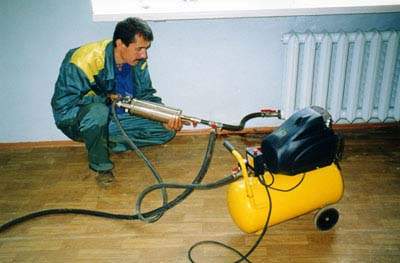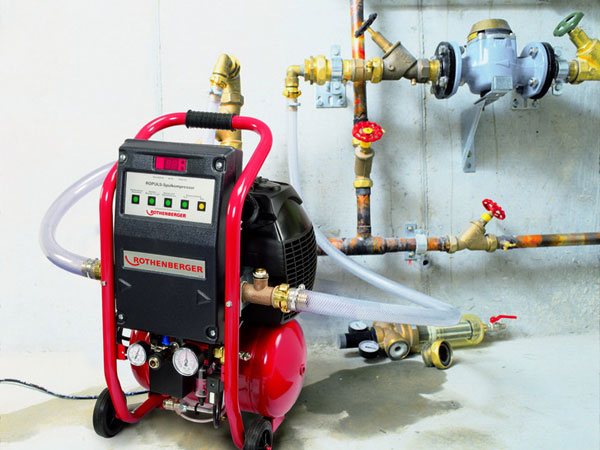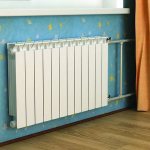Limescale, rust and debris all cause a decrease in the efficiency of the heating system Therefore, in order to avoid lowering the temperature in the house, it is necessary to regularly clean the heating radiators from the resulting blockages. In this article, we will look at how to flush heating batteries yourself, without removing, and using auxiliary equipment.
Signs of blockages
It is known that scale no more than one millimeter thick can reduce the level of heat transfer by 15%. As a result, the cost of heating the apartment is growing, but there is no effect.
The presence of contamination is accompanied by the following signs:
- heating radiators when heat is supplied warm up more slowly than before;
- some sections of one radiator are colder than others;
- the temperature of the riser is higher than the batteries in the room;
- the houses are cooler than those of the neighbors;
- the battery heats up unevenly: the top is warmer than the bottom.

When to clean heating radiators
The main indicator of the level of comfort is the room temperature. According to the established norms, the minimum indicator for apartments and residential buildings is 18 ° C, but many begin to feel comfortable only when this figure reaches 21 ° C, and maybe even higher. What to do if the temperature in the apartment is below the established standards, and representatives of utilities claim that they supply heat in full. Most likely, this is the case, it is just that the radiators are clogged in your apartment - a problem that you have to meet quite often. The following factors indicate that your radiators require flushing:
- when trying a heating riser, you suddenly find that its temperature is much higher than the temperature of the heating radiators;
- in one room the radiators work with maximum efficiency, while in the other they are barely warm or do not heat at all;
- it is warm in your neighbors' apartment on the riser, and you do not stop complaining about the quality of heating in your apartment;
- the heating radiator in its upper part is slightly warm, and its bottom is cold;
- the radiator sections do not warm up equally.
If at least one of these symptoms is found, then it is necessary to start "treating" your radiators.
This can be done in different ways, but it is necessary to do this, since you still have to pay for heating. And what to pay for, you ask yourself a completely logical question. Thus, without postponing, the problem must be solved. If you still do not know how to flush a heating radiator, we recommend that you talk to experts, or carefully read this manual.


Pneumatic impulse cleaning of the radiator
Causes of blockages
The reason for this unpleasant situation is the low quality of the coolant of the central heating system, which contains various kinds of impurities and debris. There are also features of deposits, depending on the material of manufacture of the device. Cast iron batteries have a rough inner surface and are susceptible to scale and rust formation. Aluminum and bimetal radiators are prone to lime deposits due to the calcium, magnesium and sodium content of the water.


How to flush cast iron radiators
The efficiency of the cast-iron radiators, the decrease in their heat transfer depends on many factors, including the cleanliness of the internal cavities. The high temperature of the coolant contributes to the accumulation of scale on the walls of the sections.Radiators can dry out from periodic draining and filling, which leads to corrosion. Particles of scale, rust, and other mechanical impurities that get inside due to poor water filtration mix with the coolant and clog batteries and pipes. As a result, the quality of heating decreases, and fuel consumption increases.


Periodic flushing of cast-iron batteries with your own hands helps to cope well with such a problem. This work can really be done on your own without resorting to the help of any firms. Prepare and follow the sequence for cleaning.
Signs by which you can understand that it is necessary to clean heating devices:
- Uneven heating of the radiator. At normal pressure and temperature in the network, there is no airing, the top of the battery is hot and the bottom is cold. Or vice versa. And also with hot supply pipes - the radiators are barely warm.
- The heating system takes longer to warm up than usual.
- A clear symptom of the presence of large contaminants in the battery is an increase in energy consumption.
Cleaning methods
To flush heating batteries, four methods are used that do not require dismantling the radiators. They can be used during the heating season.
Chemical method
It is the most popular cleaning method due to its simplicity and minimal cost. This method is not suitable for cleaning aluminum radiators. During purification, organic and inorganic acids and various alkaline compounds are used, which are placed in a special container with a pump.
The cleaning solution is poured into the heating system for a certain time, depending on the degree of contamination.
Prices for solutions for flushing heating systems
for flushing heating systems
Hydrodynamic method
To carry out flushing by a hydrodynamic method, special equipment is required, this is a high-pressure hydrodynamic jet machine. Before flushing, the coolant is completely drained from the system. Next, the apparatus hose with a special nozzle is placed in place of one of the dismantled pipes. In this way, deposits are removed with a fine jet of high pressure water. At the end of the procedure, water is passed through the system several times to remove dirt residues.


Pneumatic hydraulic impulse technology
In the pneumohydroimpulsive flushing method, a special pneumatic compressor is used. Impulse kinetic waves and air bubbles are formed in the water under the influence of the equipment, which, when they collapse, create shock waves. These waves remove deposits. Equipment for the application of the above methods can be rented, or you can contact specialized services that will quickly and efficiently perform the work.
Pneumatic Compressor Prices
pneumatic compressor
Hydropneumatic method
For hydropneumatic cleaning, a hydropneumatic compressor is used. The device is connected to the metering valve of the radiator, and by forcing air in the water, it creates turbulent eddies that remove fragile salt deposits.
To clean batteries at home using the above methods, you will need to rent the necessary equipment. And you can also contact specialists who will clean the heating system with high quality.


Centralized battery flushing
Do-it-yourself cleaning of cast-iron batteries is a good thing, it costs nothing, but it requires a lot of effort, given how much they weigh and time. If you involve heating network workers in this procedure and get "good" from your neighbors, you can get the result much more efficiently than fiddling with radiators in the bath on your own.
To do this, you need to submit an application to the management company and pay for the cost of the service. A similar procedure is carried out exclusively in high-rise buildings, and it does not require the dismantling of heating network elements.
Workers carry out cleaning with a special hydropneumatic compressor. Its essence is as follows:
- Water is supplied under strong pressure into the system at regular intervals, which fills it with air bubbles.
- Riding through pipes and radiators, the bubbles knock down rust, scale and debris in the channels on their way, taking it all out.
- Repeated rinsing with air-filled water until it is clear and clear will ensure good cleaning performance.
This is the most effective way to clean cast iron batteries without removing them from the wall, but which takes time and money.
Although this method seems to be the easiest for busy people willing to pay for such a service, organizational issues and waiting for permission can take some time.
Centralized cleaning or individual
Residents of apartment buildings can clean the heating system individually and centrally. Utilities provide these services using mainly hydropneumatic technology. But for this, the procedure must be coordinated with the neighbors; certain material costs will also be required. Centralized flushing can take time. For owners of private houses, only individual cleaning is possible.


Preparing for flushing
Before you wash the radiator, you must first of all do the following:
- It is better to start such a flushing before the start of the heating season - it is advisable to choose a day when the housing services have already blown the heating main, but the water has not yet been started up. Ideal - if you agree with all the neighbors in the riser about a one-time cleaning of the radiators in their apartments. So you will not leave the pieces of mud plying back and forth with the water any chance.


Dismantling required
- Prepare the container where the remaining water from the heating main will drain after dismantling, first put it in the right place
- Dismantle the radiators using a suitable locksmith tool. Remove them from the pins.


Cover the drain with a similar grate
- All plugs must first be removed from cast iron batteries.
- Cleaning is best done in the bathroom. You need to prepare it for this: lay a rag inside so as not to knock down the enamel layer, and put a special mesh on the drain hole. This is to prevent large dirt particles from clogging it.


Better to clean outside
Advice! If the risers are clogged in an apartment building, then there will be no big sense from flushing the radiator - the dirt will again, after a while, cram into it. It is necessary to negotiate with the neighbors about a comprehensive purge of the highway.
DIY rinsing
In order to independently flush heating batteries (aluminum and cast iron), without involving hazardous chemicals and complex devices, the radiators will have to be dismantled.
Sequencing:
- Preparation of tools and sites. For the procedure, you will need the following tools: a set of keys, paint, sealing tow, a large container. When dismantling, most likely, the contents of the batteries will spill, so you need to cover the floor with plastic wrap, and additionally lay a rag on it. It is also necessary to move the furniture standing next to it, remove the curtains and, if possible, cover the walls. In the conditions of the apartment, a bathroom will be used, so you should take care of the covering and tiles. In the bath itself, you should put a wooden pallet and a mesh on the drain into the sewer.
- Dismantling. When removing the radiator, shut off the coolant supply valve or drain the water from the system.Next, unscrew the radiator and drain the remaining water into the prepared container. The battery can now be moved to the bathroom.
- Flushing. For convenience, unscrew the plugs and shutoff valves. Next, we pass a stream of hot water under pressure through the radiator. If there is a lot of dirt and water does not help, you can use a solution of soda ash, vinegar, citric acid, car radiator cleaners, or other available acid-base compounds. To do this, you need to put the plugs back in place, and pour the cleaning solution for a couple of hours. During the action of the reagent, it is recommended to tap on the radiator to enhance the reaction. Then rinse thoroughly with water and repeat the procedure if necessary.
- Return to place. It is necessary to wipe the radiator, seal the plugs with tow and cover with paint. Do-it-yourself installation of heating batteries in an apartment, follow the link.
Self-cleaning of the radiator
How to rinse cast iron batteries from rust is no less important question than "how to do it." Conventionally, this process can be divided into two methods: chemical action on pollution and mechanical.
Household chemicals are most often used as descaling agents, debris and rust.:
- Pipe cleaners such as "Mole".
- Chemical solutions containing caustic soda.
- Citric or acetic acid.
- Means for washing car radiators.
The work is divided into three stages:
- First, hot water is poured without any additional funds. There should be enough of it in the radiator that, when shaken, it hits the walls and beat off the top layer of dirt and scale from them. After these manipulations, drain the water and proceed to the next stage.
- At this level, you can use special tools. If this is 70% vinegar essence, then one bottle per battery will be required, and add special cleaning agents according to the instructions. After the solution is poured, the battery is closed with plugs and left for an hour or two so that it has time to dissolve the layers on the walls of the radiator. After the expiration of the time, the chemical solution is drained and the next part of the work begins.
During this procedure, you can lightly tap on the radiator from time to time with a wooden hammer to speed up the process of detachment of dirt and rust from the walls of the cast-iron battery.
- The third stage is the final flushing of the radiator. It is good if the water pressure is strong enough in the apartment, in which case the work will take less time, especially if you pour water directly from a hose without nozzles. It is necessary to pass water through the battery until it becomes clean at the outlet. After that, the process can be considered complete.
It is not enough to know how to clean cast iron batteries. If the third stage is carried out poorly and in haste, then it may turn out that part of the chemical solution remains inside, which will cause the formation of a new layer of rust. Flushing should go until the water passing through the heater is completely cleaned.

















